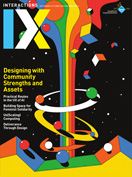Authors:
Lucy Pei, Marisol Wong-Villacres, Sheena Erete, Daniela Rosner, Alex Taylor, Mikael Wiberg
Is technology design for everyone? Across the history of computing, we can see how many initial efforts focused on the design of workplace computing tools and consumer products, where a human-centered approach entailed finding and satisfying the needs of a user in a resource-rich setting. But who is pictured as the user? Who is privileged, and who is rendered invisible? In short, whom do we design for? Recently, much work in design and HCI has focused on minoritized communities. We use minoritized following theorist José Muñoz, who uses the term "to index citizen-subjects who, due to antagonisms within the social such as class, race, and sex, are debased within the majoritarian public sphere" [1]. Minoritized communities are often also underrepresented, underserved, and underresourced; the concept of being minoritized emphasizes power relationships over demography or a dehistoricized description of resource distribution. It is crucial for researchers and practitioners engaged with minoritized communities to grapple with power relations between designers and communities, while recognizing, valorizing, and leveraging the assets, strengths, and capacities that are present in communities typically recognized by their limits.
A group of researchers and designers have been drawing upon various traditions that validate and center community strengths to propose an assets-based approach to the design of technology. These include the anti-oppression pedagogy of the Mississippi Freedom Schools and Orlando Fals Borda's work on participatory action research, as well as the evolving work of assets-based community development. Stefano Harney and Fred Moten, in their discussion of the Mississippi Freedom Schools curriculum and the fight for civil rights in the U.S., recognize that asking about what the community needs that they/we do not have is important. However, Harney and Moten emphasize that the question that comes first is, "What do we have that we want to keep?":
What [this] question presupposes is (a) that they've got something that they want to keep, and (b) that not only do those people who were fucking them over not have everything, but that part of what we want to do is to organize ourselves around the principle that we don't want everything they have [2].
HCI and the work of kindred fields in this space have developed insights and experiences from these traditions and extended them into the design and study of sociotechnical systems. Scholars and practitioners have combined insights and tools from social development and anti-oppression work that has come before, with the methodologies and sensibilities of areas such as participatory design and action research, to center the valorization of minoritized communities and work toward social change.
This special issue opens with the critical dialogues of researchers and practitioners working to apply assets-based design in different areas, brought together by a workshop in 2020 and continuing to build community around the challenging open questions that confront community-engaged research. Gonzales et al. present a tool kit facilitating assets mapping, built on the difficult premise of designing themselves out to enhance the long-term viability of the tools. A conversation with sociologist Akwugo Emejulu highlights the importance of questioning the power dynamics that underlie the premise of intervention. Her research reminds us of the importance of the context in which the theories we draw upon were formed, and challenges us to actively assert our own chosen values into our assets-based design work. J. Maya Hernandez and Veronica Ahumada-Newhart operationalize the connection between assets-based design work, social movements, and power distributions in their elaboration on an assets-based inclusive design framework, drawing from their lived experiences and work on Latine digital health. Edgard David Rincón Quijano, Angela D.R. Smith, Reem Talhouk, and Frederick van Amstel, all researchers and designers with deep community engagements, share their perspectives in a roundtable discussion on the ways they deployed assets- and strength-based approaches in their work, while presenting nuance in the strategic ways that needs and even weakness can be used toward the goals a community might have.
Lucy Pei, Marisol Wong-Villacres, Sheena Erete (guest editors) Daniela Rosner, Alex Taylor, Mikael Wiberg [email protected]
1. Muñoz, J.E. Cruising Utopia: The Then and There of Queer Futurity. New York Univ. Press, 2009.
2. Harney, S. and Moten, F. The Undercommons: Fugitive Planning & Black Study. Minor Compositions, 2013.
Copyright held by authors
The Digital Library is published by the Association for Computing Machinery. Copyright © 2022 ACM, Inc.








Post Comment
No Comments Found